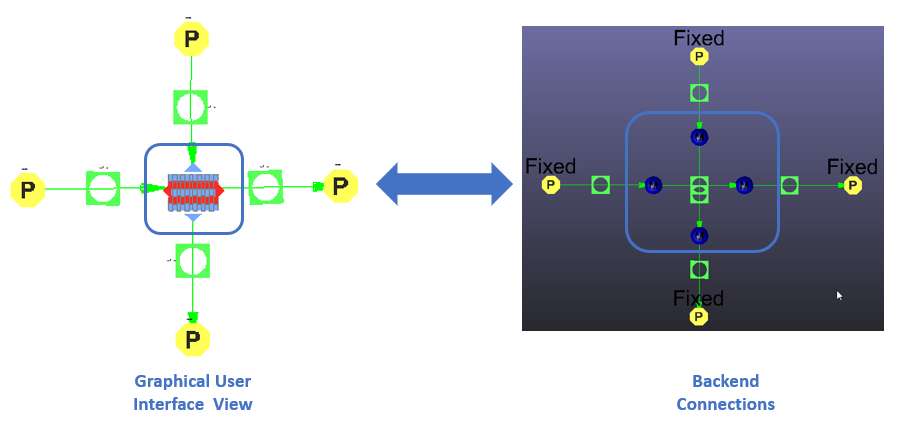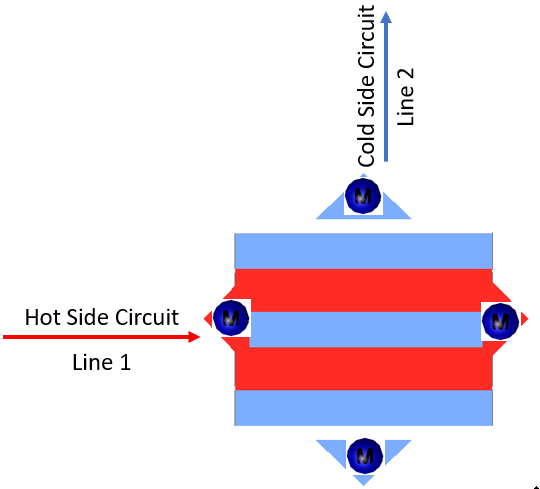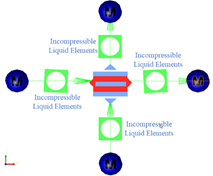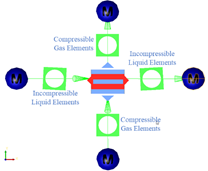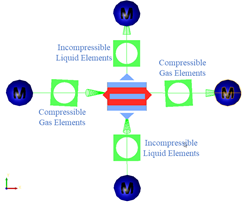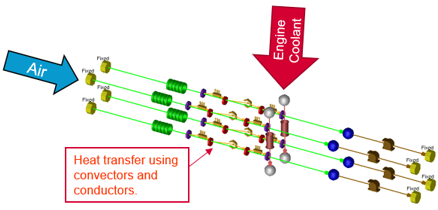- Heat Input (Qin)
- Hot Fluid Delta.T
- Cold Fluid Delta.T
- Effectiveness
- Effectiveness vs Flow_Rate_Cold vs
Flow_Rate_Hot
Effectiveness is obtained from User Defined
Input for Effectiveness as function Flow_Rate_Cold and
Flow_Rate_Hot.
- Effectiveness vs NTU vs Heat Capacity Ratio
Effectiveness is
obtained from User Defined Input for Effectiveness as function NTU and
Heat Capacity Ratio.
UA is calculated from
Constant user input or from curve specified for Nusselt Number as
function of Reynolds Number Cold and Reynolds Number Hot
- Nusselt Number vs RE_Cold vs RE_Hot
Nusselt Number is
obtained from User Defined Input for Nusselt Number as function of
Reynolds Number Cold and Reynolds Number Hot
- Constant hA Coefficient value
NTU Effectiveness
Methods:
- Cross Flow Unmixed
- Counter Flow
- Parallel Flow
- Cross Flow Both Side Mixed
- Cross Flow One Side Mixed
Cmin is mixed:
Cmax is mixed:
- Hs Parameter Methods (Constant and vs Hot and Cold
Flowrates)
The Hs parameter is typically used to describe
radiators where the hot side is a liquid coolant, and the cold side is
air.
A heat exchanger effectiveness can
be calculated using the Hs parameter.
Q is found using the effectiveness
Qmax. The Q is applied to the fluid streams to get the exit
temperatures.
- Fixed Hot (or Cold) Fluid Exit Temperature
Specify the temperature at the
exit of the heat exchanger for the hot or cold stream. The heat flow (Q)
is calculated for a hot (or cold) stream and applied to both
streams.
are specificed as inputs.
- Hot (or Cold) Fluid Exit Quality
Specify the fluid quality at the exit of
the heat exchanger for the hot or cold stream. The heat flow (Q) is
calculated for a hot (or cold) stream and applied to both streams. The
solver calculates the Q from the enthalpy change required to change the
quality to the target exit value. The source of the fluid properties
must be Coolprop for this option. Also, the energy balance option must
be “enthalpy based energy balance”. The energy balance option is found
in .
- NTU Constant
Specify the NTU for the heat exchanger. The NTU, hat capacity
ratio, and HX configuration are used to calculate the heat flow (Q).
- Hot (or Cold) Fluid Subcool Delta T
Specify the fluid temperature
difference below the saturation temperature at the exit of the hot (or
cold) stream. The heat flow (Q) is calculated for a hot (or cold) stream
and applied to both streams. The solver calculates the Q from the
enthalpy change required to change the phase from gas to liquid (if
needed) and the temperature of the liquid to the target temperature. The
source of the fluid properties must be Coolprop for this option. Also,
the energy balance option must be enthalpy based energy
balance. The energy balance option is found in the .
- Hot (or Cold) Fluid Superheat Delta T
Specify the fluid temperature
difference above the saturation temperature at the exit of the hot (or
cold) stream. The heat flow (Q) is calculated for a hot (or cold) stream
and applied to both streams. The solver calculates the Q from the
enthalpy change required to change the phase from liquid to gas (if
needed) and the temperature of the gas to the target temperature. The
source of the fluid properties must be Coolprop for this option. Also,
the energy balance option must be enthalpy based energy
balance. The energy balance option is found in the .

